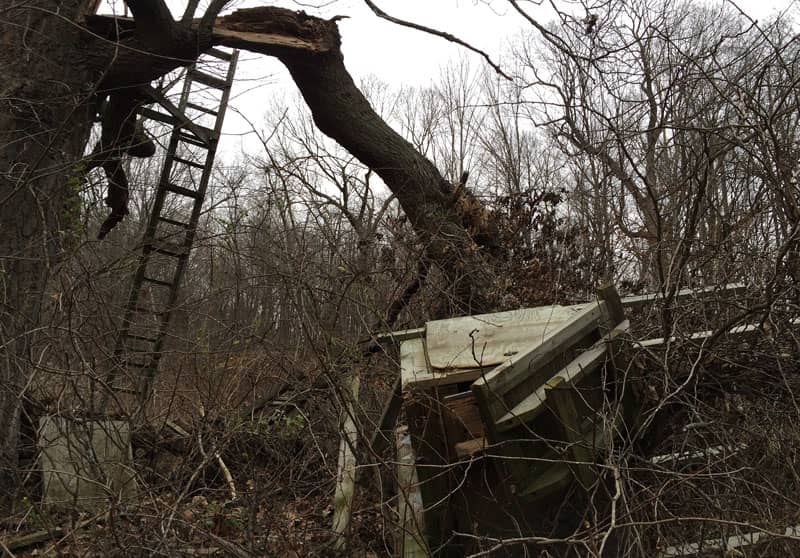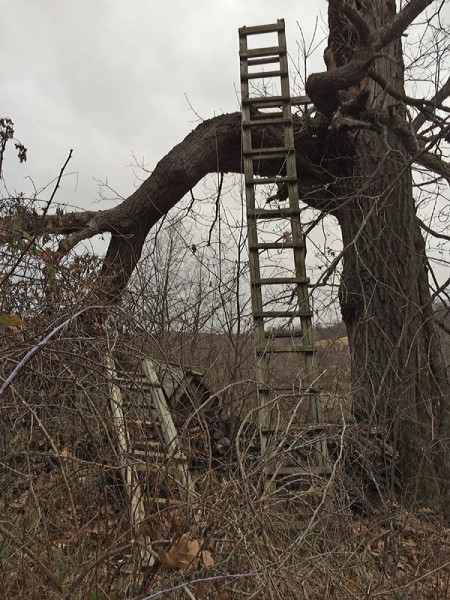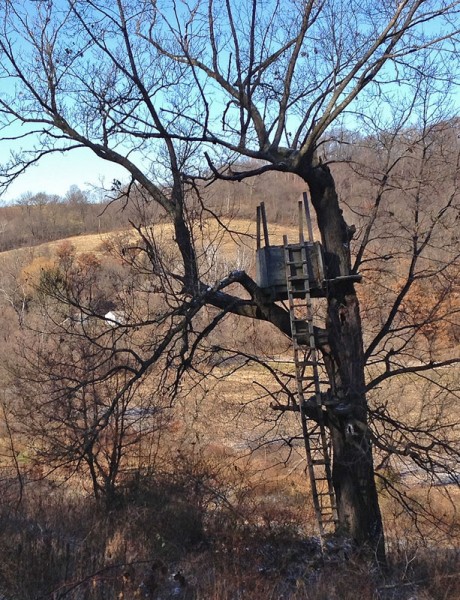A Treestand Falls, But Memories Remain
Patrick Durkin 12.17.15

Roughly 26 years after I nailed a bunch of treated lumber into an aging red oak on my aunt and uncle’s farm in southwestern Wisconsin, it all came crashing down when a late-summer storm swept the valley.
But I realized two years ago the deer stand’s time had come. After sitting in the old box stand for four hours on opening weekend of the 2013 gun season, I carefully descended, vowing to never again climb into it. As I sat there that cold morning, I noticed the big spikes anchoring its platform to the oak had pulled through the boards and disappeared into the growing branches, leaving the 2-by-6s to hug the tree with gravity and tension alone.
The box never lost its grip, however. Instead, rot sapped the old oak’s strength where its trunk forked into its largest branch, the one cradling my stand. When the branch broke at the joint and fell with my stand, it also snapped off my homemade ladder when it refused to let go.
Only after hitting the ground did the box finally pop loose of the branch. I took some pride in that, knowing my maternal grandfather, Joseph Frank, would approve. Although he worked as a butcher and sausage-maker in his own meat market in Cross Plains, Wisconsin, Grandpa Frank was also a self-taught carpenter who built functional stuff that endured.
As I inspected the wreck November 20, the day before Wisconsin’s gun season, I recalled building the stand’s four walls in the garage of our first home in Omro, Wisconsin. I also remember designing the walls’ height to serve as shooting rests. I covered each wall with scraps of plywood left over from remodeling our porch. The plywood didn’t last. Squirrels gnawed it full of holes the next five years, forcing me to cover everything with treated plywood by the mid-1990s.
My buddy Mark Endris helped me put it all together on a cold Friday in November 1989. I used screw-in steps to reach it that first gun season, and then Endris helped me build a sturdy 25-foot ladder for it the next summer, and hoist it into place with pulleys and rope. And when I decided my daughter Leah, then six, should hunt with me in 1991, Endris helped me add a small wing to the main box.
Those thoughts reminded me of Leah’s first hunt that November. Wet, heavy snowflakes splattered our faces and clothes on opening morning, and yet she fell asleep inside her private box. When she awoke, we shared a hot chocolate and I assured her the deer would come.
About 9:15 a.m., she hissed “Deer!” and pointed east up the valley. A doe led two fawns downhill, across the creek and into the cut cornfield. If they had continued across the field, they would have been safe. Instead, they followed a barbwire fence west on a parallel course to my waiting rifle. My shot caught the doe through its chest. It leaped the fence, ran about 20 yards up hill, and fell on the snow-mottled pasture.

Leah sat alongside me the next nine years, so she was there in 1995 when we heard my nephew, Case Christensen, then 13, shoot near the farm’s northern border where he was hunting with his stepfather, Mike Dibble. We weren’t carrying walky-talkies, and so we waited and watched a distant hilltop for about a half-hour, hoping to see Case appear and signal success.
Just about the time we thought he must have missed, Case’s orange hat came into view. Seconds later he yanked the hat from his head and waved it happily. That was our signal to grab my camera and photography gear to get some pictures of Case’s first deer, an eight-point yearling buck.
In 1997, Leah, then 12, carried a rifle and deer license for the first time. She passed up a yearling buck about 9 a.m., and then missed a yearling doe about an hour later as it moved along the wooded hillside above our stand. I recall urging her to shoot the buck, but she had seen me pass up several such yearlings in recent years, and had adopted my standards as her own. If I wouldn’t shoot a yearling buck, neither would she.
Leah eventually shot a doe that season, but not until after Thanksgiving, and then from a seat cushion with a bipod on the distant hill.
When the 2000 gun season arrived, Leah was 15 and desiring independence. I sat alone in the old box stand, glancing occasionally at her empty seat nearby. She was hunting from a tripod stand we set up not far from where her cousin had triumphantly waved his hat five years before. All I could see of her was her orange cap, about 600 yards away.
About 10 a.m., I heard Leah shoot and looked her direction. A large buck was running my way. If Leah had shot at it, she had certainly missed. The buck trotted my way down the fallow CRP field, crossed the road 200 yards away, and dashed across the cut cornfield toward the fence below, never offering a shot.
Then it hopped the barbwire and stood still at about 50 yards, seemingly placing the large branch of a nearby maple between me and its chest. The wind was blowing from me toward the buck, so I felt certain it would spook any second. After detecting a tight shooting lane with my scope, I squeezed the trigger of my bolt-action rifle.

The buck trotted uphill as I jacked another round into the chamber. I shot again, thinking I was finishing him off. But I wasn’t. The buck accelerated and disappeared into the neighbor’s woods after hopping another barbwire fence. When I descended to check the snow for blood, I discovered my first shot had shattered a three-inch maple branch, and the second shot had cut a furrow in the light snow. The buck was gone.
Leah and I had walky-talkies by then, so I filled her in and she consoled me. “Well, at least it was a clean miss,” she said. “Maybe you’ll see another one later.”
But y’know, I never again spotted a big buck from that stand, although I hunted it every opening day except two between 2001 and 2013.
Even so, I still have great memories of all those openers from that box stand, and my logs verify I shot 15 deer while seated there.
All that’s left to do now is clean up the wreckage and salvage some wood for my next memorable box stand.

